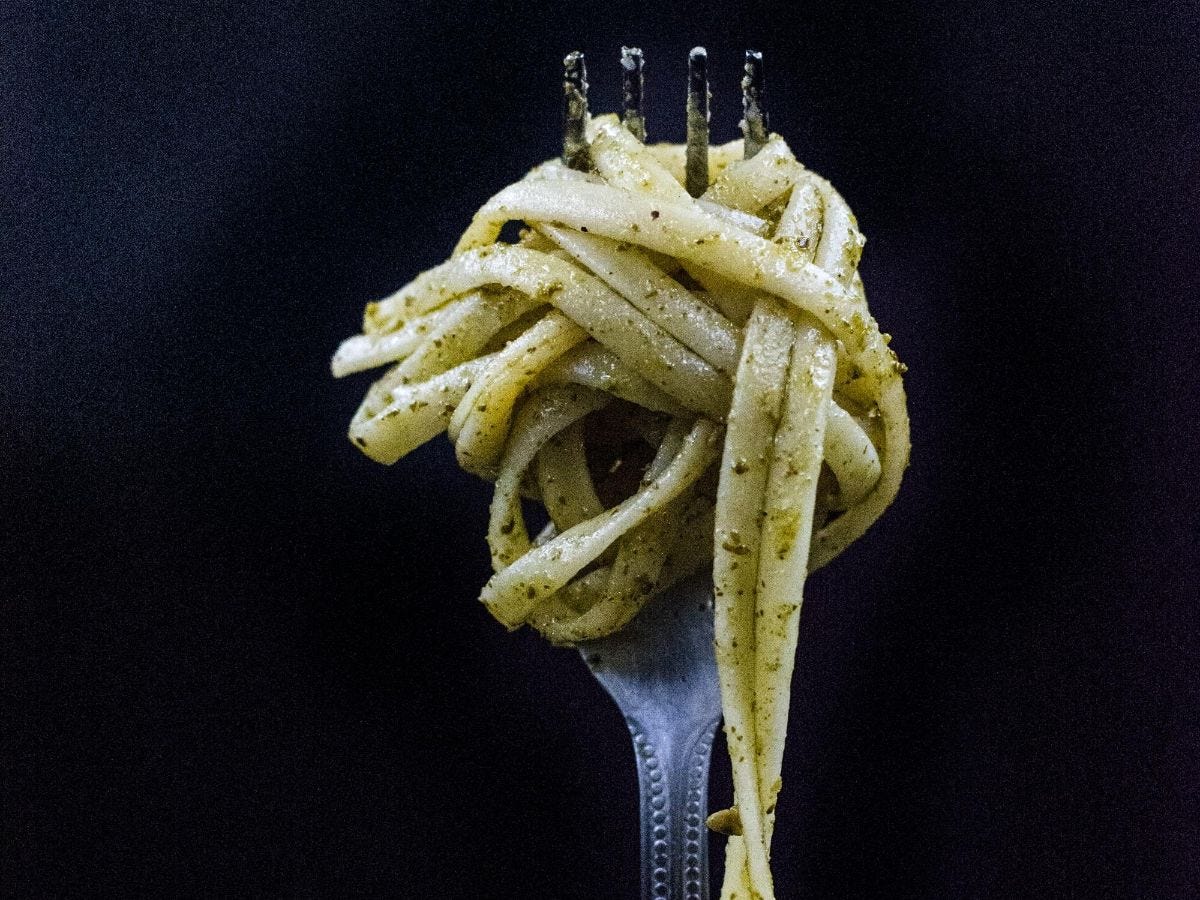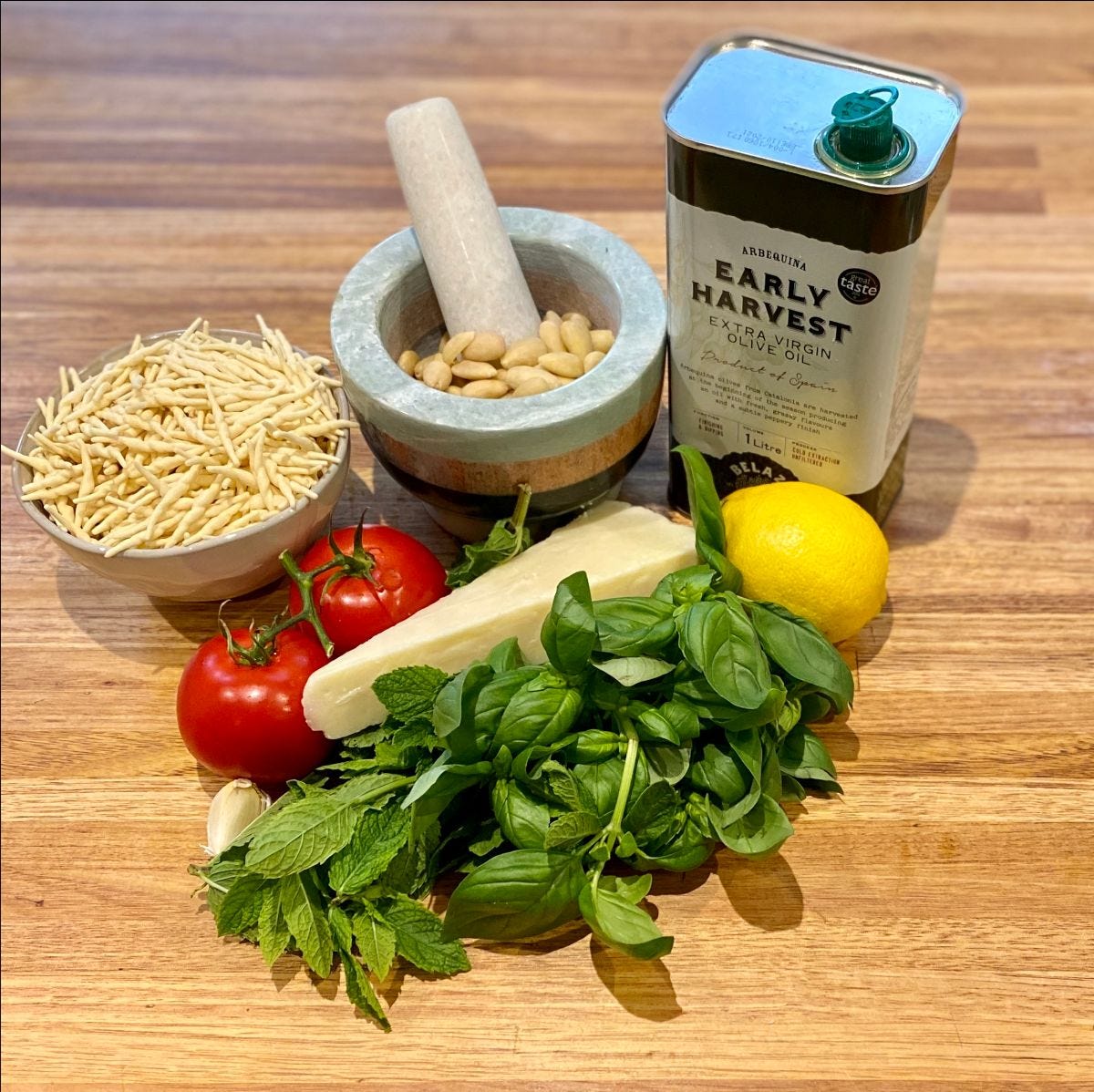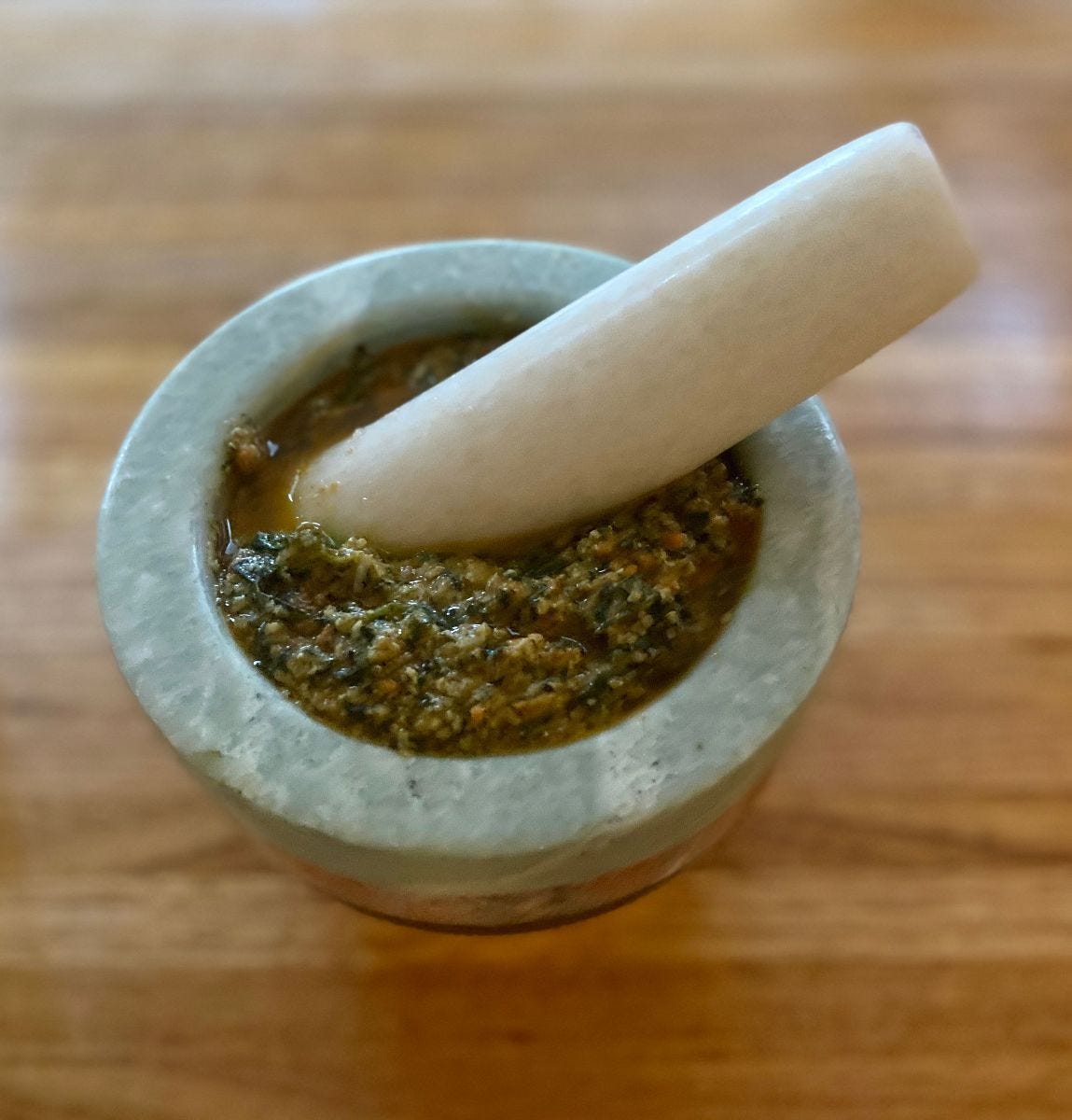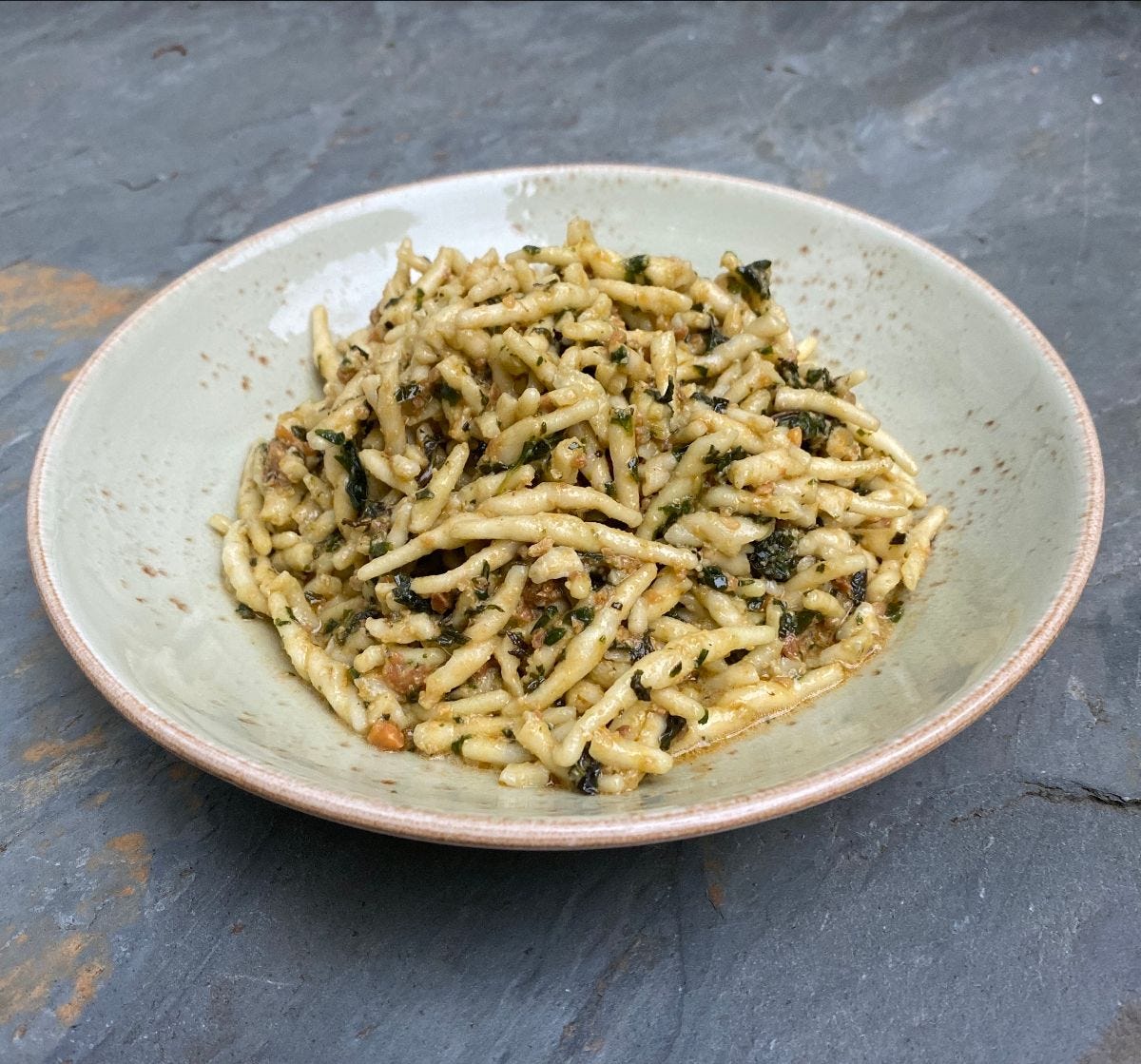Reviving a uni classic
Freshers week. Missed lectures. Jägerbombs. The heady days of university.
This week we’re revisiting them by upgrading what would have been a go-to dish for many... Swap pasta with pesto, for pesto alla Trapanese.
It’s basically a tomato and almond pesto sauce. Quick to make (30 mins) and quick to eat (time varies depending on current lockdown appetite / weight gain).
This week’s album
I Put A Spell On You by Nina Simone
Because who doesn’t need more Nina Simone in their lives? There are so many albums to choose from, but this one has a couple of her biggest hits. At just over 30 minutes, you may even finish it before you finish this week’s cooking.
A Sicilian summer
Pesto alla Trapanese is a Sicilian variation on the traditional pesto alla Genovese (your ‘normal’ pesto).
Hailing from the province of Trapani in north west Sicily, the story goes that the dish came about in ancient times when the Genoese ships would use the port of Trapani as a pit stop. The Genoese would share their recipes with the locals, who in turn adapted the pesto recipe using Sicilian ingredients.
Pine nuts and Parmesan were out. Almonds and Pecorino were in. Along with some ripe vine tomatoes to lighten the sauce.
Of course this story may be total nonsense.
Either way, the technique for making sauces like this has been around forever…
The word ‘pesto’ comes from the verb ‘pestare’, meaning to pound or to crush, and refers to the use of a pestle and mortar (one of the earliest bits of kitchen equipment going). Some quick google research told me that scientists have found pestles and mortars that date back to approx. 35000 BC.
114 days into lockdown and my internet search history is all over the place.
Put a fork in it: this is your standard pesto colour.
Ours will be a bit darker with a red tinge.
If you can use a pestle and mortar this week then do. It’s more traditional. The end result has a better texture. And the crushing helps to extract more flavour. If you don’t have one then a small blender will do the trick.
I’ve suggested serving this sauce with pasta (obvs) which you can eat hot as soon as the pasta is cooked. Having said that, traditionally this dish is eaten lukewarm or at room temp so do what suits your meal planning this week.
If you’re making it in advance and refrigerating it, just make sure you let it come back to room temp before you eat it otherwise you won’t get the full effect of the flavours.
What you need
The below serves 4 people (as a starter/light pasta). It takes 20 mins to prep and 10 mins to cook the pasta.
50g almonds (blanched/skin off)
2 vine tomatoes
½ garlic clove
40g pecorino (finely grated)
4 tbsp of olive oil
Small bunch basil (about 30g, leaves picked)
Small bunch mint (about 30g, leaves picked)
Squeeze of lemon
Black pepper
Sea salt
250g durum wheat pasta (such as trofie)
Two quickies:
1. Pecorino is made with rennet and therefore isn’t vegetarian. If you want to substitute it then the same amount of a vegan hard cheese will work.
2. Trofie pasta works well here as the pesto sauce covers all of the pasta - giving you sauce and pasta with every bite - but any durum wheat pasta can be used.
Ready, steady, cook
1. Preheat your oven to 190°c (170°c fan) and place a medium-sized pan of salted water on to boil.
2. Toast the almonds in the oven for 6-8 mins or until golden brown. Leave them to cool.
3. Cut an ‘x’ slit into the top and bottom of each tomato with a sharp knife. When the water is boiling, blanch (basically scald) the tomatoes for 30 seconds and then immediately transfer to a bowl of cold water.
Once cool, peel the skin from the tomatoes. They should come away easily. Cut them into quarters and remove the seeds. At this point you can switch the heat off the pan and place a lid on it to retain the heat for cooking the pasta later.
4. Add your garlic and a small pinch of salt to a mortar. Crush everything into a paste. Add the toasted almonds and continue to crush into a rough paste. Start with a tapping motion to break down the almonds into smaller pieces without them flying everywhere. Then work more vigorously.
5. Work in the basil and mint leaves, and again crush until a paste is formed. If you need to, you can add a small amount of the olive oil at this stage which can help with breaking down the leaves.
6. Next, incorporate the cheese. If you’ve managed to grate it finely it will mix in easily. If it’s not already really fine just keep grinding with the pestle until it breaks down.
7. Add the tomatoes and bind them into the paste. Add the olive oil and mix thoroughly. The final sauce should be a rough paste with little chunks of almonds.
8. Finally, adjust the seasoning. Add in a squeeze of lemon, which will help to cut through the richness of the cheese, and a good amount of fresh black pepper.
NOTE: Pecorino is particularly salty so, if adding extra salt, do so carefully. The little bit added with the garlic at the beginning is often enough.
9. If adding your pesto to pasta, return the hot water to a rolling boil. Add the pasta and cook according to packet instructions. With previous pasta dishes we have added the pasta to the sauce when it is ‘al dente’ and continued to cook for a few minutes. This isn’t done when using pesto.
We don’t want to cook the pesto as it’s raw, and cooking it will dramatically change the flavour. So drain the pasta and reserve a cup or so of the cooking water. Mix the pesto thoroughly through the drained pasta and loosen, if necessary, with some of the reserved cooking water.
Final thought
I’ve added this sauce to pasta, but of course you can use it for other things. Like as a dip for crudités, or spread on bruschetta with a spoon of ricotta.
Whatever you decide to do, enjoy this week’s culinary trip to Sicily.
Same time next week,
Fraser
Last week’s results
Painting a pretty picture?
Tag your dishes with #eatmywordslondon, or hit reply to this email with a photo.










